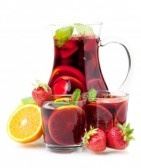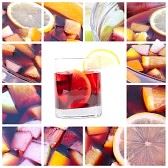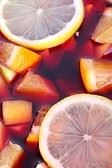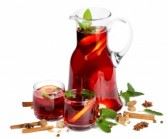Think of Spain, and you think of sun, sea and Sangria - or so the cliche goes. Sangria comes in many shapes and sizes, from pleasantly light and refreshing, for a hot afternoon, to ‘Comes with a Health Warning’ for an evening of serious partying. The mixture also varies from undrinkable - usually the ready-made variety - to absolutely wonderful. You won’t encounter undrinkable in a Spanish bar; every Spaniard I’ve ever met can rustle up spectacular Sangria. It’s a talent they’re born with.
One of the best Sangrias I’ve ever tasted cost only 5 Euro for a 1 litre jug at a cafeteria in a Sunday market. The secret is to soak the fruit in the alcohol for at least an hour before completing the Sangria. Everywhere that I’ve considered the Sangria to be worth a return visit, there are always jugs of fruit and wine waiting to be mixed and enjoyed. Any bar using tinned fruit instead of fresh should be avoided. That’s the cheat’s way, and you can’t cheat with Sangria. The first sip gives you away.
At the risk of sounding conceited, I must say that my rocket fuel sangria is legendary. If there's a problem with it, it's that it slips down too easily. Our friends have a saying for this - when they've overdone it on the sangria, they tell people they've been 'Piddocked.' I'm thinking of submitting it to the Oxford English Dictionary as a new word, once I've ironed out the finer points of the definition.
One friend who didn't heed the warnings of those who'd been Piddocked before him gave us a good laugh, although it took a couple of days before his wife would speak to him without a look of pure contempt on her face. After supping sangria well rather than wisely, he fell down the terrace steps and landed in Tony's gladioli bed. The 4 feet high specimens were cut off in their prime, and he emerged covered in bark chippings and pink gladioli flowers, which rather clashed with his orange shirt.
We were laughing so much that we failed to notice his - very expensive - sunglasses were missing. We found them, bent and broken, as we tried to resuscitate the gladioli, but he'd already gone by then. He obviously hadn't missed them either, because when he got home, he spent twenty minutes trying to take off his non-existent sunglasses, before saying, 'Bugger it - I'll just have to sleep in them' and collapsing into bed. Here's how to make my special sangria.
I usually make two 1 litre jugs – one is never enough, and if there is any left over –unlikely, but it may happen – it will store in the fridge for a couple of days in a covered jug. Remove the fruit before storing, though. Chop the fruit into small pieces about ½ inch square. Leave the skin on everything, except mangoes or kiwi fruit. Prepare enough fruit to give 2 – 3 inches depth in the jug.
What fruits to use? Anything that takes your fancy, is in season, and is ripe enough for the juices to flow. Avoid bananas, as they start to break up in the alcohol almost immediately and will make your drink cloudy. We live on the Costa Blanca, where oranges are cheap, juicy and plentiful. Strawberries are lovely at the moment, as are plums and melons. I always add some apple, as well. If you don’t want too much sweetness, add some lemon or lime.
Now add alcohol. My favourite blend is brandy, sherry and red wine. How much? That’s up to you. For a refreshing but not overly strong Sangria, I use 4 single measures of brandy, 1 wineglass of sherry and 2 large glasses of wine in a 1 litre jug. Don’t waste money on decent red wine. An ordinary table wine or ‘vino de mesa’ is fine for Sangria. Allow the fruit and alcohol to stand for an hour or more.
To finish your Sangria, add plenty of ice, then top up with lemonade or gaseosa For special occasions, or for higher alcohol content, use half lemonade and half cava. Stir well and serve, ensuring everyone gets some ice and fruit in their glass.
For children or drivers, prepare non-alcoholic Sangria using red grape juice, apple juice and lemonade. Left over fruit from your Sangria will store in the fridge for two days. It makes a tasty topping for ice cream, cheesecake or yogurt, but be careful, as the fruit will contain alcohol. Remember, making good Sangria is an art, not a science. The correct quantities are those that work for you. Enjoy!



